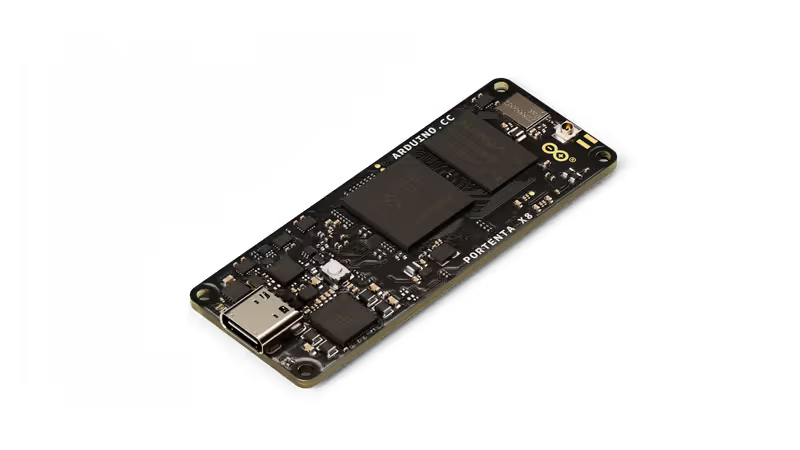Deploying Edge AI Models with Docker Containers
Deploying machine learning models at the edge is crucial for real-time data processing in industrial applications. This article explores how Docker simplifies Edge AI deployment on the Arduino Portenta X8, enabling scalable and secure AI implementations on embedded Linux systems.

The Arduino Portenta X8 combines embedded Linux and microcontroller capabilities.
The Importance of Edge AI Deployments
Edge AI refers to the practice of running artificial intelligence models directly on edge devices, such as sensors, smartphones, or industrial machines, rather than relying solely on centralized cloud servers.
Some Arduino boards based on a microcontroller – such as those in the Portenta family (Portenta H7, Portenta C33) or Opta – allow running Edge AI natively, leveraging tools like Tiny Machine learning.
This approach offers several advantages:
Reduced Latency: Processing data locally enables real-time decision-making, which is essential for applications like autonomous vehicles and industrial automation.
Enhanced Privacy: Keeping data on-device minimizes the risk of exposure, addressing privacy concerns in sectors like healthcare and finance.
Bandwidth Efficiency: Local processing decreases the need to transmit large volumes of data to the cloud, reducing bandwidth usage and associated costs.
However, deploying AI models on edge devices presents challenges, including limited computational resources and the need for efficient model management.
Leveraging Docker for Edge AI
Docker containers encapsulate applications and their dependencies into isolated environments, ensuring consistency across deployments. This is particularly beneficial for edge AI due to:
Simplified Deployment: Containers bundle the application code, libraries, and configurations, eliminating dependency conflicts and streamlining the deployment process.
Portability: Docker ensures that applications run uniformly across different environments, making it easier to deploy models on various edge devices.
Resource Efficiency: Containers are lightweight compared to traditional virtual machines, making them suitable for devices with constrained resources.
Implementing Docker for edge AI deployments can lead to more manageable and scalable solutions, as it abstracts the underlying hardware and provides a uniform interface for application deployment.
Implementing Edge Impulse Models with Docker
To deploy an Edge Impulse model using Docker on an embedded Linux platform, follow these steps:
Model Training: Develop and optimize your machine learning model using the Edge Impulse platform, which provides tools for collecting data, designing algorithms, and validating performance.
Container Setup: Utilize a pre-configured Docker image that includes the necessary runtime libraries for your model. This involves creating a Dockerfile that specifies the base image, installs dependencies, and copies the model into the container.
Deployment on Embedded Linux: Execute the containerized model on your target hardware, leveraging its processing capabilities for efficient inference. Docker’s portability ensures that the model runs consistently across different devices.
This methodology simplifies AI implementation, making it accessible for engineers involved in industrial automation, predictive maintenance, and intelligent sensing applications.
The Role of Portenta X8 in Edge AI Deployments
For developers looking for a hardware platform that efficiently bridges embedded and industrial applications, the Arduino Portenta X8 offers a compelling solution. With its combination of embedded Linux and microcontroller capabilities, it provides:
Multi-Core Processing: A powerful heterogeneous architecture that enables real-time AI inference while handling additional processing tasks.
Linux Compatibility: The ability to run containerized applications seamlessly, offering flexibility for edge AI implementations.
Connectivity Options: Built-in support for Wi-Fi, Bluetooth, and Ethernet, essential for real-time data transmission and remote management.
By leveraging the Portenta X8’s capabilities alongside Docker, developers can streamline the deployment of machine learning models while maintaining security, scalability, and performance at the edge.
Get Started with the Full Guide
To deploy your own Edge Impulse models using Docker, explore the step-by-step tutorial here and begin integrating intelligence into your edge devices today.